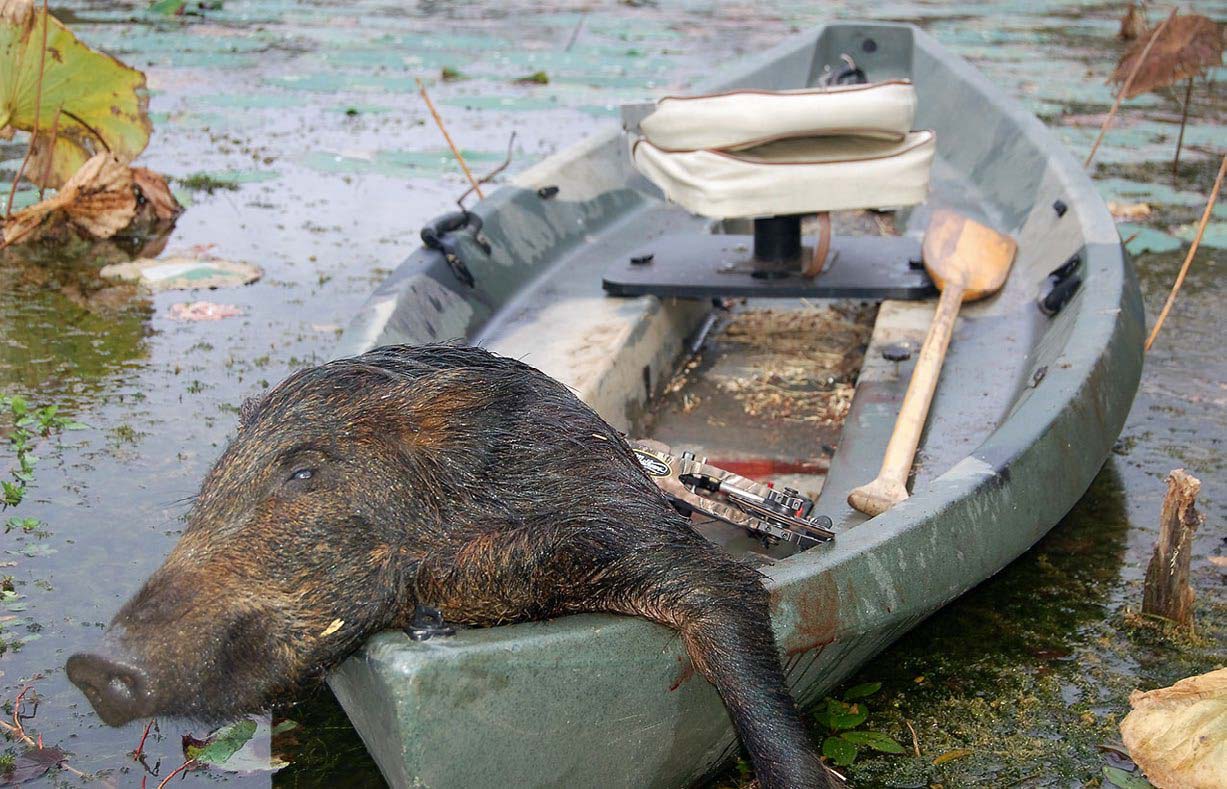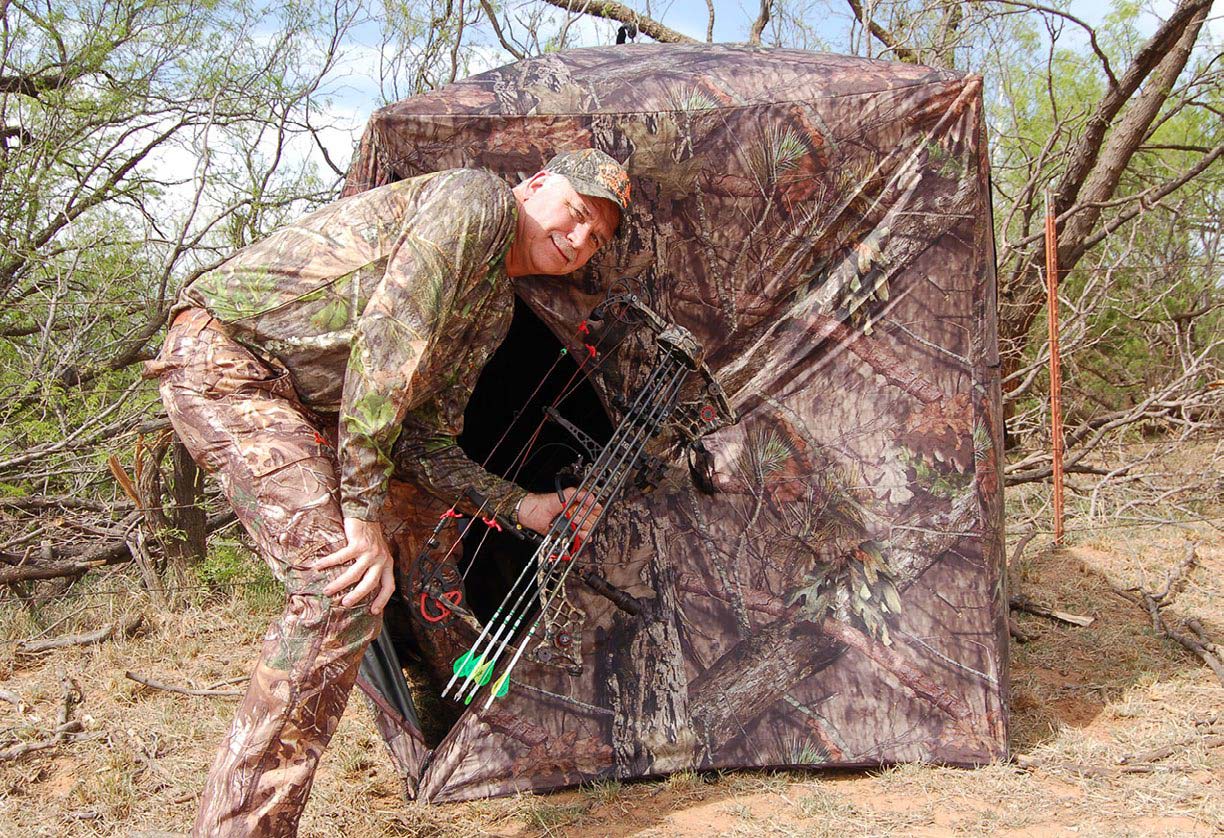Wild hogs are smart, wary critters with an olfactory system better than that of a bloodhound. It’s scientific fact that hogs can detect odors as far as five miles away and up to 25 feet underground. To get close, within bow range, you must do all you can to ensure they do not smell you.
Regardless of the method you use to control your scent, expect to get occasionally busted by the critter’s keen nose. If he gets even the slightest whiff of your presence, you will hear a snort back in the woods and hear brush breaking as your boar makes a mad dash for cover. Hogs are not like deer. Don’t expect them to run to the first cover and stop and look back. When a hog is spooked, he’s spooked, and his mind is focused on putting as much distance between himself and the danger he is perceiving as quickly as possible.
But don’t be discouraged. I’ve taken countless hogs while still hunting as well as hunting from blinds around corn feeders. The adrenaline rush you experience when a noisy sounder of hogs is making its way through the woods toward you is the stuff that keeps me coming back to the hog woods after more than 50 years of hunting them!
In truth, hogs are way easier to stalk or still hunt than deer, even with their radar-like noses. It’s been said that hogs are half-blind, but don’t you believe it. I have a buddy who owns a hunting ranch. One day we baited the dam of his small lake with corn, planning to still hunt below the impoundment late in the afternoon and hopefully pop up and arrow a porker. Back at camp, a good 400 yards away, we spotted a small group of hogs early in the afternoon. It was much earlier than we expected them to be out feeding. I remember mentioning how at that great distance, we probably could just close the distance by walking straight to the hogs. My friend grinned and said the hogs probably already had eyes on us.

“Check this out,” he says, as he takes his coat off and begins waving it in the air. I was watching through binoculars and sure enough, every one of the hogs stopped crunching corn, faced us, and gave us a long stare before deciding we were too far away to be a threat, then resumed their mid-day snack. Just before dark, we arrowed a fat “eater” hog on top of the dam. We used the heavy cover below the dam to stalk within bow range.
Here in Texas, where I do the majority of my hog hunting, baiting is legal and the majority of hogs I’ve killed have been near a corn feeder or a bait pile. But I also enjoy still hunting or stalking them. Hogs are very vocal critters when traveling through the woods to and from feeding areas. Boars are notorious for “hogging” food. They’re also quick to whack any nearby hog with their snout when they are feeding. It’s common to hear a sharp squeal when this occurs.
Many ranches have corn feeders with timers that are usually set to sling corn in the morning at first light and again about 30 minutes before dark. I love to still hunt with my bow during prime time around these feeders. I always make my approach from downwind and use every bit of available cover, I’ve arrowed many porkers with this method. When approaching feeding hogs, keep a close eye on their tail, and when their heads are down. For hogs feeding, their tails will be spinning like a pinwheel. You can expect the porkers to approach a baited site with caution, but once they begin feeding, they are usually oblivious to what’s going on around them. I look for a tree or brush to use for cover and very slowly ease into shooting position.

Mid-Day Shoot
Mid-day can also be an excellent time to hunt bedded hogs. Again, playing the wind is an absolute must. The drill is to approach likely areas from downwind and move very slowly. When you think you are moving slowly enough, slow down a bit more! A few steps per minute is fast enough. Stop and listen every couple of steps.
On many occasions, I’ve walked up on sleeping hogs. Once, when hunting very heavy cover in eastern Texas, I actually heard a boar snoring! The sound was only 25 or so yards away and I slipped up very slowly to within 15 yards and arrowed the 150-pound boar in his bed. Granted, this was the exception rather than the rule, but it proves how effective the art of listening for hogs can be. Even when hunting over bait, it’s very common to hear a sounder of hogs coming from a great distance. Lone mature boars are the exception, though. Boars seldom run with sounders of sows/pigs. Unless there is a sow in estrus in the group, they tend to be secretive loaners, and if pressured, they become warier than an old Whitetail buck. They move through the woods much like deer, and it’s impossible to fool their nose. It’s common for them to test the wind and circle a baited area just like a Whitetail buck does coming into rattling antlers.

Indirect Approach
When still hunting, I seldom make a direct approach, especially when hogs are moving through the woods feeding. I’ve had much better success by determining the route or direction the hogs are traveling (they often use well-defined pig trails) and then getting ahead of the hogs and off to one side. Then I let them come to me. It’s usually necessary to close the distance to get within bow range and this requires moving very slowly and using trees and brush for concealment.
Hogs carry their vitals a bit farther toward the front of their body and lower than deer. A “behind the shoulder” shot on wild hogs often results in a hit to the gut, no blood trail, and an unrecovered animal.
The very best shot placement on broadside hogs is in the lower third of the body close to the front shoulder. Smaller hogs up to about 125 pounds seldom have a thick shield protecting their front shoulders. A good broadhead can usually punch right into the vitals with a shoulder shot. But older boars have a thick, very tough shield that is hard to penetrate. When bow hunting bigger boar, it’s best to wait for a slightly quartering away shot and angle the arrow from just behind the shoulder up into the heart/lung area. I have a longtime friend who has outfitted hog hunts in eastern Texas since the late 1980s. He advises his hunters to shoot for the front of the hog. If the shot opportunity presents itself, a neck shot is deadly. Even with a hog facing you, it’s possible to slip a good sharp broadhead into the neck area, which will cause massive hemorrhaging to an artery in the neck or penetrate the heart-lung region.
As far as whether mechanicals or fixed blades work best, I can say from experience that I have had excellent results with both when I did my job and placed the broadhead in the right spot. I’ve heard the stories of mechanicals not opening on hard quartering-away shots. With certain mechanical broadheads under certain conditions, that could be the case. However, I can honestly say, from my own experience, that I can’t agree. I always wait for either a broadside or slightly quartering shot (with the exception of a head-on shot, which can be lethal).
Hunting over bait is often highly successful, but it’s definitely not the only method of finding and killing wild hogs.

Nuts and Onions
Wild porkers are quick to find any available food source in the fall when acorns or pecans are falling. I’ve had great success still hunting in pecan orchards or around oaks. Hogs continue rooting and uncovering soured nuts well into the winter months. They also love hickory nuts, and they actually consume the entire nut, shell and all. It’s interesting to watch a sounder of hogs feeding on hickory nuts. With their powerful jaws, they can easily crunch the tough nuts. They do it with the same kind of ease as how we eat popcorn. In early spring when green grass is emerging, hogs will graze much like cattle. It is common to find them out feeding on green fields. Wild onions are one of the porker’s favorite foods. Because of the strong onion smell, I’m sure it is one of the easiest things for them to locate from a great distance.
Wild hogs are loads of fun to hunt, regardless of the method you use. But I can tell you from much experience that getting close—really close—to a big boar, and harvesting him with a well-placed arrow, is one of hunting’s finest moments.
Luke Clayton has been hunting hogs for over 40 years, mostly in Texas, and way before hog hunting became popular. Listen to his radio show on www.catfishradio.org, where there is always plenty of “hog talk.”

Per our affiliate disclosure, we may earn revenue from the products available on this page. To learn more about how we test gear, click here.





